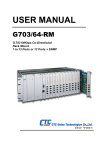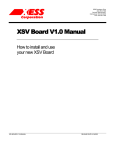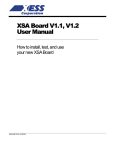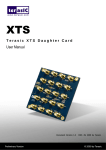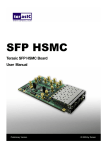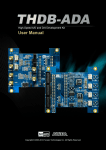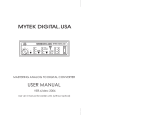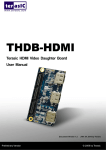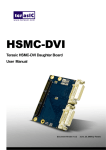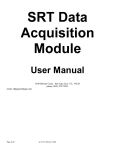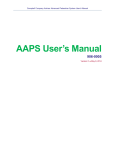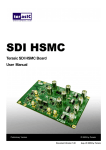Download SATA User Guide - Digi-Key
Transcript
Terasic THDB-H2G VERSION 1.0 March 1, 2010 Copyright © 2003-2010 Terasic Technologies Inc. All Rights Reserved. Introduction Page Index INTRODUCTION ..............................................................................................................................................................................1 1.1 FEATURES ....................................................................................................................................................................................1 1.2 ABOUT THE KIT............................................................................................................................................................................3 1.3 GETTING HELP.............................................................................................................................................................................3 ARCHITECTURE .............................................................................................................................................................................3 2.1 LAYOUT AND COMPONETS ...........................................................................................................................................................3 2.2 BLOCK DIAGRAM..........................................................................................................................................................................7 BOARD COMPONENTS.................................................................................................................................................................8 3.1 HSMC EXPANSION CONNECTOR ................................................................................................................................................8 3.2 I2C SERIAL EEPROM ..............................................................................................................................................................16 3.3 SATA/SAS CLOCK ....................................................................................................................................................................17 3.4 SATA/SAS SINGLE LANE CHANNEL .........................................................................................................................................18 3.5 SATA/SAS 4 LANE CHANNEL ...................................................................................................................................................19 3.6 CONFIGURATION, STATUS AND SETUP ELEMENTS....................................................................................................................20 3.4 ATX POWER ..............................................................................................................................................................................21 DEMONSTRATION........................................................................................................................................................................22 4.1 INTRODUCTION...........................................................................................................................................................................22 4.2 SYSTEM REQUIREMENTS ..........................................................................................................................................................23 4.3 SETUP THE DEMONSTRATION ....................................................................................................................................................24 4.4 DEMO OPERATION .....................................................................................................................................................................27 APPENDIX ......................................................................................................................................................................................27 5.1 REVISION HISTORY ....................................................................................................................................................................27 5.2 ALWAYS VISIT SATA W EBPAGE FOR NEW MAIN BOARD ...........................................................................................................27 ii Introduction 1 Introduction The SATA/SAS daughter card is designed to provide SATA interface conversion for FPGA platforms that support SAS and SATA solutions based on the latest 40-nm technology through a High-Speed Mezzanine Connector (HSMC). It allows users to access storage devices through the SATA/SAS protocols on an FPGA specifically the Stratix IV GX, Stratix II GX, Arria II GX, and Cyclone IV GX devices. This card features 4 single channel SATA signal plug connectors, one 4 channel SATA/SAS connector, and one ATX style output power connector for hard drives. With the SATA interface conversion established on the HSMC interface, your FPGA system can bridge different protocols enabling the FPGA to be a system on chip (SOC), plus with the SATA/SAS IP core on the FPGA it can be used for functionality, specification-compliance, interoperability, and performance testing. The SATA/SAS daughter card is the ideal platform for SATA interface conversion ensuring an excellent way to develop SOC solutions for storage applications on the Altera’s 40-nm FPGAs with integrated transceivers. 1.1 Features 1-1 Figure 1.1 shows the photo of the SATA/SAS card. The important functions of the card are listed below: • HSMC interface o 8 high speed interfaces supporting SATA / SAS communications at 1.5Gbps, 3 Gbps and 6Gbps data rates • o 6 out-of-band signals supported for the 4 lane connector o Dipswitch inputs on CMOS input section of HSMC o LED drive outputs for 16 bi-color LEDs (32 connections) SATA/SAS Single lane interface o • SATA/SAS 4 lane interface o • Internal style vertical surface mount connectors Internal style 32 pin vertical surface mount connector ATX power o Standard ATX 4 pin connector providing 1 Amp on both 12V and 5V power rails from host boards able to support current • 8 Kbit I2C EEPROM • Differential clocking for 150MHz and 300MHz reference clocks through the HSMC or SMA connectors 1 Introduction Figure 1.1. The picture of the SATA/SAS card 2 Introduction 1.2 About the KIT This section describes the package content • SATA/SAS HSMC card x 1 • SATA crossover ribbon cable x 2 • System CD-ROM x 1 * The SATA crossover ribbon cable is only used for loopback testing purposes. Please do not attempt to connect SATA hard-disk using this cable. The CD contains technical documents of the SATA/SAS card Figure 1.2 SATA/SAS card Package 1.3 Getting Help 1-2 Here are some places to get help if you encounter any problem: Email to [email protected] Taiwan & China: +886-3-550-8800 Korea : +82-2-512-7661 Japan: +81-428-77-7000 3 Architecture 2 Architecture This chapter describes the architecture of the SATA/SAS card including block diagram and components. 2.1 Layout and Componets 1-3 The picture of the SATA/SAS card is shown in Figure 2.1 and Figure 2.2. It depicts the layout of the board and indicates the locations of the connectors and key components. 4 Architecture User Dip SW Power 5V 12V SMA SATA_CLK_OUT CLK_OE, CLK_FS ATX Power SATA/SAS Single Lane Channels RX0 TX0 LEDs RX1 TX1 LEDs SATA/SAS 4x Channel RX/TX 4-7 LEDs Figure 2.1 The SATA/SAS Card PCB and component diagram 5 Architecture Figure 2.2 The SATA/SAS card back side – HSMC connector view The following components are provided on the SATA/SAS card : • HSMC Connector (J12) • User Dip SW (SW1) • SMA SATA_CLK_OUT (J1/J2) • SATA/SAS Single Lane Channels (J3/J4/J8/J9) • SATA/SAS 4x Channel (J5) • ATX Power (J11) • CLK_OE (J6), CLK_FS (J7) 6 Architecture 2.2 Block Diagram 1-4 Figure 2.3 shows the block diagram of the SATA/SAS card. Figure 2.3. The block diagram of the SATA/SAS Card 7 Board Components 3 Board Components This section will describe the detailed information of the components, connector interfaces, and the pin mappings on the SATA/SAS card. 3.1 HSMC Expansion Connector 1-5 This section describes the HSMC connector on the SATA/SAS card The SATA/SAS card contains an Altera standard HSMC connector. All the other interfaces on the SATA/SAS card are connected to the HSMC connector. Figure 3.1 shows the pin-outs of the HSMC connector and Table 3.1 lists the description of each signals corresponding to the HSMC connector. 8 Board Components Figure 3.1 The pin-outs of the HSMC connector. 9 Board Components Table 3.1 below lists the HSMC signal direction and description Pin Name Numbers 1 Direction (with respect Description to the FPGA board) HSM_TX_P7 Output Differential transmit data output before DC blocking capacitor 2 HSM_RX_P7 Input Differential transmit data input before DC blocking capacitor 3 HSM_TX_N7 Output Differential transmit data output before DC blocking capacitor 4 HSM_RX_N7 Input Differential transmit data input before DC blocking capacitor 5 HSM_TX_P6 Output Differential transmit data output before DC blocking capacitor 6 HSM_RX_P6 Input Differential transmit data input before DC blocking capacitor 7 HSM_TX_N6 Output Differential transmit data output before DC blocking capacitor 8 HSM_RX_N6 Input Differential transmit data input before DC blocking capacitor 9 HSM_TX_P5 Output Differential transmit data output before DC blocking capacitor 10 HSM_RX_P5 Input Differential transmit data input before DC blocking capacitor 11 HSM_TX_N5 Output Differential transmit data output before DC blocking capacitor 12 HSM_RX_N5 Input Differential transmit data input before DC blocking capacitor 13 HSM_TX_P4 Output Differential transmit data output before DC blocking capacitor 14 HSM_RX_P4 Input Differential transmit data input before DC blocking capacitor 15 HSM_TX_N4 Output Differential transmit data output before DC blocking capacitor 16 HSM_RX_N4 Input Differential transmit data input before DC blocking capacitor 17 HSM_TX_P3 Output Differential transmit data output before DC blocking capacitor 18 HSM_RX_P3 Input Differential transmit data input before DC blocking capacitor 10 Board Components 19 HSM_TX_N3 Output Differential transmit data output before DC blocking capacitor 20 HSM_RX_N3 Input Differential transmit data input before DC blocking capacitor 21 HSM_TX_P2 Output Differential transmit data output before DC blocking capacitor 22 HSM_RX_P2 Input Differential transmit data input before DC blocking capacitor 23 HSM_TX_N2 Output Differential transmit data output before DC blocking capacitor 24 HSM_RX_N2 Input Differential transmit data input before DC blocking capacitor 25 HSM_TX_P1 Output Differential transmit data output before DC blocking capacitor 26 HSM_RX_P1 Input Differential transmit data input before DC blocking capacitor 27 HSM_TX_N1 Output Differential transmit data output before DC blocking capacitor 28 HSM_RX_N1 Input Differential transmit data input before DC blocking capacitor 29 HSM_TX_P0 Output Differential transmit data output before DC blocking capacitor 30 HSM_RX_P0 Input Differential transmit data input before DC blocking capacitor 31 HSM_TX_N0 Output Differential transmit data output before DC blocking capacitor 32 HSM_RX_N0 Input Differential transmit data input before DC blocking capacitor 33 SMB_SDA Inout I2C EEPROM address/data I/O 34 SMB_SCL Inout 35 - - - 36 - - - 37 JTAG_TDO_TDI Inout JTAG 38 JTAG_TDO_TDI Inout JTAG 39 - - - 40 - - - 41 SATA_RX_LED_ Output R7 11 I2C EEPROM serial clock Red LED signal serial Board Components 42 USER_DIPSW7 Input 43 SATA_RX_LED_ Output User control input from dipswitch Green LED signal G7 44 USER_DIPSW6 Input User control input from dipswitch 45 3V3 Power Power 3.3V 46 12V Power Power 12V 47 SATA_RX_LED_ Output Red LED signal R6 48 USER_DIPSW5 Input 49 SATA_RX_LED_ Output User control input from dipswitch Green LED signal G6 50 USER_DIPSW4 Input User control input from dipswitch 51 3V3 Power Power 3.3V 52 12V Power Power 12V 53 SATA_RX_LED_ Output Red LED signal R5 54 USER_DIPSW3 Input 55 SATA_RX_LED_ Output User control input from dipswitch Green LED signal G5 56 USER_DIPSW2 Input User control input from dipswitch 57 3V3 Power Power 3.3V 58 12V Power Power 12V 59 SATA_RX_LED_ Output Red LED signal R4 60 USER_DIPSW1 Input 61 SATA_RX_LED_ Output User control input from dipswitch Green LED signal G4 62 USER_DIPSW0 Input User control input from dipswitch 63 3V3 Power Power 3.3V 64 12V Power Power 12V 65 SATA_RX_LED_ Output Red LED signal R3 66 - - 67 SATA_RX_LED_ Output Green LED signal G3 68 - - 69 3V3 Power Power 3.3V 70 12V Power Power 12V 71 SATA_RX_LED_ Output Red LED signal 12 - Board Components R2 72 - - 73 SATA_RX_LED_ Output Green LED signal G2 74 - - - 75 3V3 Power Power 3.3V 76 12V Power Power 12V 77 SATA_RX_LED_ Output Red LED signal R1 78 - - 79 SATA_RX_LED_ Output Green LED signal G1 80 - - - 81 3V3 Power Power 3.3V 82 12V Power Power 12V 83 SATA_RX_LED_ Output Red LED signal R0 84 SAS_SIDEBAND Inout 0 85 SATA_RX_LED_ 4 lane SATA/SAS sideband signal Output Green LED signal G0 86 SAS_SIDEBAND Inout 1 4 lane SATA/SAS sideband signal 87 3V3 Power Power 3.3V 88 12V Power Power 12V 89 SATA_TX_LED_ Output Red LED signal R7 90 SAS_SIDEBAND Inout 2 91 SATA_TX_LED_ 4 lane SATA/SAS sideband signal Output Green LED signal G7 92 SAS_SIDEBAND Inout 3 4 lane SATA/SAS sideband signal 93 3V3 Power Power 3.3V 94 12V Power Power 12V 95 SATA_TX_LED_ Output Red LED signal R6 96 SAS_SIDEBAND Inout 4 4 lane signal 13 SATA/SAS sideband Board Components 97 SATA_TX_LED_ Output Green LED signal G6 98 SAS_SIDEBAND Inout 5 4 lane SATA/SAS signal 99 3V3 Power Power 3.3V 100 12V Power Power 12V 101 SATA_TX_LED_ Output Red LED signal R5 102 - - 103 SATA_TX_LED_ Output Green LED signal G5 104 - - - 105 3V3 Power Power 3.3V 106 12V Power Power 12V 107 SATA_TX_LED_ Output Red LED signal R4 108 - - 109 SATA_TX_LED_ Output Green LED signal G4 110 - - - 111 3V3 Power Power 3.3V 112 12V Power Power 12V 113 SATA_TX_LED_ Output Red LED signal R3 114 - - 115 SATA_TX_LED_ Output Green LED signal G3 116 - - - 117 3V3 Power Power 3.3V 118 12V Power Power 12V 119 SATA_TX_LED_ Output Red LED signal R2 120 - - 121 SATA_TX_LED_ Output Green LED signal G2 122 - - 123 3V3 Power Power 3.3V 124 12V Power Power 12V 125 SATA_TX_LED_ Output Red LED signal 14 - sideband Board Components R1 126 - - 127 SATA_TX_LED_ Output Green LED signal G1 128 - - - 129 3V3 Power Power 3.3V 130 12V Power Power 12V 131 SATA_TX_LED_ Output Red LED signal R0 132 - - 133 SATA_TX_LED_ Output Green LED signal G0 134 - - - 135 3V3 Power Power 3.3V 136 12V Power Power 12V 137 SATA_CLK_OE Output Oscillator clock output enable (Active High) 138 SATA_CLK_FS Output 150MHz/300MHz oscillator frequency select 139 - - - 140 - - - 141 3V3 Power Power 3.3V 142 12V Power Power 12V 143 - - - 144 - - - 145 - - - 146 - - - 147 3V3 Power Power 3.3V 148 12V Power Power 12V 149 - - - 150 - - - 151 - - - 152 - - - 153 3V3 Power Power 3.3V 154 12V Power Power 12V 155 - - 156 SATA_HSM_CLK Input _P 157 - 150MHz/300MHz clock 15 - differential Board Components 158 SATA_HSM_CLK Input _N 150MHz/300MHz differential clock 159 3V3 Power Power 3.3V 160 HSM_PSNTn Power Power Ground 3.2 I2C Serial EEPROM 1-6 This section describes the I2C Serial EEPROM on the SATA/SAS card The SATA/SAS card consists of an 8 Kbit EEPROM which is configured through a 2-wire serial interface. The device is organized as four blocks of 256 x 8-bit memory. The detailed pin description between the HSMC and EEPROM is shown below in Figure 3.2. Figure 3.2 EEPROM connection to the HSMC connector 16 Board Components 3.3 SATA/SAS Clock 1-7 This section describes clock circuitry on the SATA/SAS card The on-board oscillator is to provide a clean low jitter reference clock at frequencies of 150MHz and 300MHz by toggling the frequency select pin (FS) for use in the high-speed SERDES TX and RX, while the output enable (OE) of the oscillator will tri-state the output pins. The oscillator output is driven to a differential clock buffer to provide two identical differential clock outputs to the HSMC and SMA connectors. Figure 3.3 depicts the connection made on the oscillator clocks and SMA connectors. Board Signal Name Description CLK_OE Jumper DNI – clock output enabled (default), Jumper Installed – Reference J6 clock output disabled (outputs tristated) J7 CLK_FS Jumper Installed – 150MHz clock selected (default), Jumper DNI – 300MHz clock selected Figure 3.3 Clock connection on the SATA/SAS daughter card 17 Board Components 3.4 SATA/SAS Single Lane Channel 1-8 This section describes SATA/SAS single lane channel on the SATA/SAS card There are 4 single channel SATA single channel links which are facilitated on the SATA/SAS card using the passive connection from the high-speed serial link from the HSMC connector to the 7-pin SATA signal plugs. The routing between the two connectors is 100 Ohm differential impedance route with DC blocking capacitors in the middle of the channel. Figure 3.4 depicts a block diagram of the SATA/SAS single lane channel. Figure 3.4 Block diagram of the SATA/SAS single lane channel 18 Board Components 3.5 SATA/SAS 4 Lane Channel 1-9 This section describes SATA/SAS 4 lane channel on the SATA/SAS card A 32 pins signal connector is used for SATA/SAS quad channel link. The connector contains 16 high-speed differential signals for SATA/SAS communications protocol. There are 10 pins used for signal ground and 6 pins for sideband signals. Figure 3.5 shows the block diagram of the SATA/SAS 4 lane channel. Figure 3.5 block diagram of the SATA/SAS 4 lane channel 19 Board Components 3.6 Configuration, Status and Setup Elements 1-10 This section describes the configuration, status and setup elements of the SATA/SAS card Configuration: A jumper (J10) is available to disable the 12V to 5V regulator. If the on-board power output connector is not used it is recommended that the switching regulator be disabled by placing this jumper. Setup: An eight position user dip switch shown in Figure 3.6 is supplied on the board to enable developers to have application specific user supplied setting. The dip switched is configured so that in the shorted position the higher number pins (9-16) are shorted to ground. The lower number pins (1-8) are connected to user signals that are attached to the HSMC lower speed signaling. The user dip switch can be used to control various modes depending on the user design. As with any user interface proper de-bouncing counters and synchronization circuitry is required for any proper design. Figure 3.6 Eight position user dip switch Status LEDs: Component reference for LEDs describes board reference description signaling standard for the LEDs located on the SATA/SAS card. Each channel has a bi-colored LED for TX and RX LED Color Description D5 Blue 5V power D9, D11, D2, D4 Bi-color Off/Red/Green/Orange SATA/SAS transmit status (user function driven) (single lane transmit channels) D8, D10, D1, D3 Bi-color Off/Red/Green/Orange SATA/SAS receive status (user function driven) (singe lane receive channels D16, D17, D18, Bi-color off/Red/Green/Orange 20 SATA/SAS transmit status (user function driven) Board Components D19 (4 lane transmit channel) D12, D13, D14, Bi-color off/Red/Green/Orange D15 (4 lane receive channel) SATA/SAS receive status (user function driven) 3.4 ATX Power 1-11 This section describes the ATX power provided on the SATA/SAS card The SATA/SAS card consists of an ATX power connector to provide power to an attached disk drive unit. A switching regulator is used to generate 5V from 12V where the connector is rated to supply 1A of each voltage for use by the disk drive. Figure 3.7 below shows the power tree of the ATX power connector. Figure 3.7 Power tree of ATX power connector 21 Demonstration 4 Demonstration This chapter illustrates the reference design for the SATA/SAS daughter card. 4.1 Introduction 1-12 This section describes the functionality of the demonstration briefly. The demonstration illustrates a loopback test for transceiver channels using the SATA/SAS daughter card and the Stratix IV GX development board. There are a total of 2 designs where the SATA reference clock is taken from different locations, HSMC connector and SMA connector respectively therefore either one can be driven. Note that if you select the HSMC connector to drive the SATA reference clock, a connection using the SMA cable is not required. Users have the option of connecting the loopback connection to the single channels of the SATA connector or establishing the connection using the SATA/SAS 4x cable. Note that the SATA crossover cables are included in the kit can be only used on the single channel of the SATA connector. Figure 4.1 and Figure 4.2 depicts the block diagram for this demonstration. The design will run a well known repeating pattern on 4 or 8 SATA channels depending on the connection. The demonstration is intended for users to provide a basic instruction to the SATA/SAS daughter card with the procedures to control different hardware and software settings. Figure 4.1 Block diagram of the SATA/SAS loopback design using the SATA loopback ribbon cable 22 Demonstration Figure 4.2 Block diagram of the SATA/SAS loopback design using the SATA/SAS 4x cable 4.2 System Requirements The following items are required for the SATA/SAS loopback demonstration. • SATA/SAS daughter card x 1 • Stratix IV GX FPGA Development Board x 1 • SATA loopback crossover signal ribbon cable x 2 (Included in the package) • SATA/SAS 4x loopback cable (optional) • SMA cable x 2 (If using the SMA SATA reference design) 23 Demonstration 4.3 Setup the Demonstration Figure 4.3, 4.4, 4.4, 4.5, 4.6, and 4.7 shows how to setup hardware for the SATA demonstration. i. Plug in the SATA/SAS daughter card onto the Stratix IV GX development board. Note: The SATA/SAS card must be connected to HSMC Slot “A” of the Stratix IV GX FPGA Development Board for this demonstration. Figure 4.3 Connecting the SATA/SAS daughter card to the Stratix IV development board ii. Set S4=[00011011] on the backside of the Stratix IV GX development board, follow by connecting the SMA clock between the SATA/SAS daughter card and Stratix IV GX development board as follows: (SATA_CLK_OUT_P ~ CLKIN_P, SATA_CLK_OUT_N ~ CLKIN_N) 24 Demonstration Figure 4.4 SMA clock connection iii. Set the SATA/SAS board for 300MHz REFCLK by removing the CLK_FS (J7) jumper. iv. Option 1 (using single SATA channel): Connect the SATA loopback ribbon cable included in the package as follows: (SATA_CH_2 ~ SATA_CH_3, SATA_CH_0 ~ SATA_CH1) Figure 4.5 SATA loopback ribbon cable connection 25 Demonstration Option 2 (using 4x SATA channels): Connect a SATA/SAS 4x cable shown below Figure 4.6 SATA/SAS 4x loopback connection v. Set USER_DIPS 0-3 = ON and 4-7 = OFF on the Stratix IV development board. Figure 4.7 Stratix IV development board User DIP SW3 settings 26 Demonstration 4.4 Demo Operation This section describes the procedures of running the demonstration FPGA Configuration Demonstration Setup, File Locations, and Instructions SATA Transceiver Loopback Test Demo using SMA ref clock: • Project directory: hsmc_loopback_dev_kit_refclk_s4gx230 • Bit Stream used: hsmc_loopback.sof • Stratix IV GX FPGA Development Kit Setup • Set S4=[00011011] on backside of the Stratix IV GX development board. Set the rotary switch (SW2) to the 0 position Power on the Stratix IV GX FPGA Development Board and download the SOF file (hsmc_loopback_dev_kit_refclk.sof) • Press the CPU_RESET pushbutton. USER_LEDS 4-7 will display the “heartbeat” pattern, indicating that the FPGA’s state machine is running. LEDS (pcie_led_x1, pcie_led_x4, pcie_led_x8, pcie_led_g2) will also display the “heartbeat pattern”. • Refer to Table 4.1 and Table 4.2 for the Pushbuttons and LED definitions. • Press and release USER_PB[0] • Press and release USER_PB[1] • Press and release USER_PB[2] • Confirm USER LEDS 0, 1, and 2 illuminate, and USER_LED 3 is not illuminated. All 8 SATA_USER_LEDs will be GREEN if this step passes. • Press both USER_PB[1] and USER_PB[2], then release both will create an error in the transmitter data stream. • Confirm USER_LED 3 is illuminated. All RX_SATA_USER_LEDs for all tested channels will be RED. • Simultaneously press USER_PB[0] and USER_PB[1], the SATA_USER_LED will show a moving ORANGE moving pattern with GREEN background. • Simultaneously press USER_PB[0] and USER_PB[2], the SATA_USER_LED will show a moving ORANGE moving pattern with RED background. SATA Transceiver Loopback Test Demo using HSMC ref clock: FPGA Configuration Demonstration Setup, File Locations, and Instructions • Project directory: hsmc_loopback_hsmc_sata_refclk_s4gx230 • Bit Stream used: hsmc_loopback.sof • Stratix IV GX FPGA Development Kit Setup • Set S4=[00011011] on backside of the Stratix IV GX development board. Set the rotary switch (SW2) to the 0 position Power on the Stratix IV GX FPGA 27 Development Board and download the SOF file Demonstration (hsmc_loopback_dev_kit_refclk.sof) • Press the CPU_RESET pushbutton. USER_LEDS 4-7 will display the “heartbeat” pattern, indicating that the FPGA’s state machine is running. LEDS (pcie_led_x1, pcie_led_x4, pcie_led_x8, pcie_led_g2) will also display the “heartbeat pattern”. • Refer to Table 4.1 and Table 4.2 for the Pushbuttons and LED definitions. • Press and release USER_PB[0] • Press and release USER_PB[1] • Press and release USER_PB[2] • Confirm USER LEDS 0, 1, and 2 illuminate, and USER_LED 3 is not illuminated. All 8 SATA_USER_LEDs will be GREEN if this step passes. • Press both USER_PB[1] and USER_PB[2], then release both will create an error in the transmitter data stream. • Confirm USER_LED 3 is illuminated. All RX_SATA_USER_LEDs for all tested channels will be RED. • Simultaneously press USER_PB[0] and USER_PB[1], the SATA_USER_LED will show a moving ORANGE moving pattern with GREEN background. • Simultaneously press USER_PB[0] and USER_PB[2], the SATA_USER_LED will show a moving ORANGE moving pattern with RED background. Table 4.1 Pushbutton Functionality Pushbutton Description Cpu_resetn Resets the Board Test System User_pb[0] Enable Comma Detect User_pb[1] Enable channel Bond User_pb[2] Start transmitting PRBS data User_pb[1&2] Creates an error in the transmitter data stream User_pb[0&1] Creates an orange on green heartbeat pattern on the sata_user_leds User_pb[0&2] Creates an orange on red heartbeat pattern on the sata_user_leds Table 4.2 LED Indicators LED Indicators Description User_led[0] PLLs are locked. User_led[1] Pattern Sync Acquired (World aligned, Channel st Bonded, 1 PRBS Data Received) User_led[2] Test Complete User_led[3] Error User_led[7:4] Heartbeat Pattern (FPGA design is functioning) 28 Appendix 5 Appendix 5.1 Revision History 1-13 Date Change Log March 1, 2010 Initial Version 5.2 Always Visit SATA Webpage for New Main board 1-14 We will be continuing providing interesting examples and labs on our SATA webpage. Please visit www.altera.com or sata.terasic.com for more information. 29
































